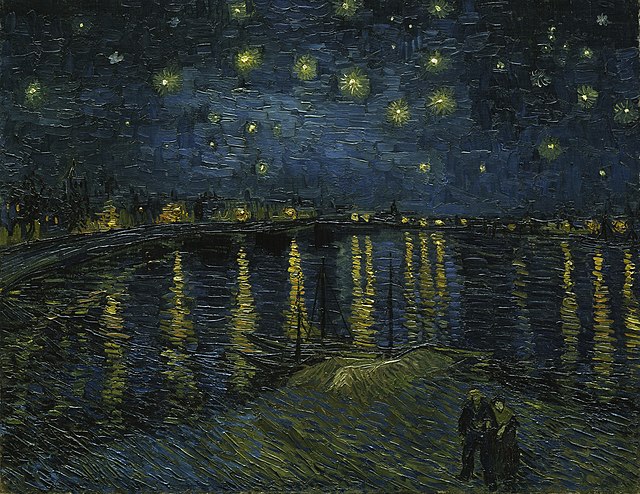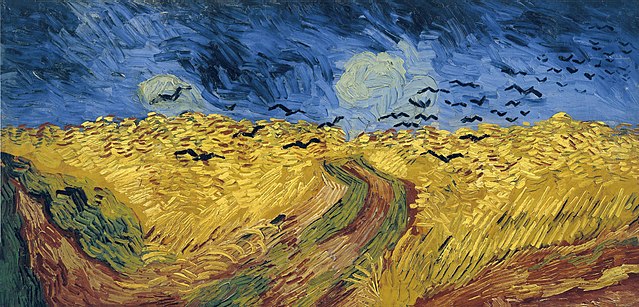Throughout his life, Vincent Van Gogh was plagued by many mental illnesses that affected his ability to function in the real world. His art was a frequent escape that quickly became an incentive to survive. His major pieces such as Poet’s Garden, Starry Night, and Wheatfield with Crows all capture deep truths about the human condition and nature – his favorite subjects. Today, we remember Van Gogh as one of the pioneers to rise out of the post-impressionist movement and an artist who is immensely celebrated. Although there are many opinions about how Vincent Van Gogh dealt with his mental illness, one can argue that his primary source of coping was through painting.
Despite being successful in society today, Van Gogh’s life was marked by failure and poverty. He was born into pain and suffering, lived through a traumatic childhood, and spent much of his adult life in asylums. He was often run out of towns, and mocked by villagers and children who were afraid of his erratic and non-conforming behavior. He, like many artists, was familiar with the despair of depression.
At the age of twenty-eight, he set out to capture glimpses of life and insight into art. Van Gogh frequently spoke with his brother about how art and nature were the only things that allowed him to experience a sense of freedom. In a letter to his brother Theo, he talks about his joy, by saying, “I would like to paint some portraits against a very vivid yet tranquil background. There are greens of a different quality, but of the same value, so as to form a whole of green tones, which by its vibration will make you think of the gentle rustle of the ears swaying in the breeze: it is not at all easy as a color scheme.”

This sentiment is captured in his painting Poet’s Garden; it’s of trees and shrubbery that are captured by a variety of greens. He placed pigments next to each other instead of mixing them to bring more life into his art. Today, this painting hangs at the Art Institute in Chicago and captures the attention of the viewer as the painting almost leaps out of the canvas for a brief moment, allowing even a blind person to feel the vibrations of his creation.
The style of Post Impressionism was first made popular by Paul Cezanne, who wanted to capture emotions through painting to have deeper symbolism. Van Gogh was naturally well-versed in the language of deep emotions and wanted nothing more than to release these emotions. The style of Post Impressionism appealed to him due to its depth and versatility. He also made nature a huge theme in his works which followed its predecessor Impressionism.

By the end of 1988, Van Gogh had once again begun to fall into depression. During this time, he painted one of his most iconic paintings: Starry night over the Rhone. Historians agree that he was on the verge of going into a deep depressive state, marked by dark colors and small glimpses of light. During this time, he was in France, surrounded by great painters, and was overwhelmed, triggering his manic episodes. Whenever he went through dark episodes, his paintings often reflected them with dark canvases and hints of optimistic light.

Wheatfield with Crows was one of Van Gogh’s final paintings before his death. In this painting, he captures a path between a field that symbolizes the long road paved with the isolation that leads to an eternal city. The crows symbolize the ancient wisdom that we find on this path in nature. They observe everything, yet remain free and prudent. Van Gogh was constantly inspired by nature, and in another letter to Theo, he mentions, “Sometimes I long so much to do landscape, just as one would for a long walk to refresh oneself, and in all of nature, in trees for instance, I see expression and a soul, as it were.” To Van Gogh, nature was an escape from the materialistic world, as well as from his own mind. Through his paintings, he captured the sounds, scents, and colors of everything from plants, water, and the skies.
Van Gogh is one of the most renowned figures in the art world today. However, like many artists, his life was stripped of that recognition. Van Gogh’s paintings allow us to catch a glimpse of his mind and how he was deeply misunderstood by society. In the same wheat field that Van Gogh once painted so passionately, he would eventually meet his demise as well. Many people say that he killed himself, but some historians argue that it wouldn’t have been possible due to the angle of the bullet. Despite this, Van Gogh insisted on his deathbed that he alone was responsible for his death by saying, “My body is mine, and I am free to do what I want with it.” He was born into suffering and led a life stained with mental illness and grief, but he died free. His art allowed him to escape his reality and gave him compassion, insight, and empathy. It had given him catharsis.
